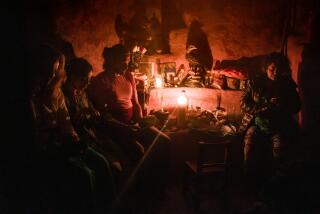Project May Put Shiitake Mushrooms on U.S. Side of Trade Balance With Japan
DANVILLE, Ill. — Shiitake mushrooms, one of the most popular delicacies in Japan, are popping out of 700 neatly stacked logs in a secluded Vermilion County research site.
These large, expensive mushrooms could be a key to reducing soil erosion, improving forest management and creating wildlife habitat, while making money for people who grow them, scientists say.
“We’re in this for the environmental aspects,” said Kenneth Konsis, the Kennekuk Cove Park forester who teaches the art of shiitake production. “The mushrooms are a financial incentive to get landowners to do this.”
Scientists say adding trees to erodible crop land can help keep valuable soil from washing away; cutting smaller logs can improve existing forests. In either case, wildlife should benefit.
$100 Million in Imports
Shiitake production also could help the U.S. economy, since this nation now imports about $100 million worth of the mushrooms from Japan each year. The U.S. Department of Agriculture estimates that domestic growers have a $2-million annual market now, and it eventually could be 10 times that much.
“We’re growing higher-quality mushrooms than they are in Japan,” Konsis said. “They are buying our best mushrooms and shipping them back to Japan.”
The Vermilion County research project, developed two years ago by wildlife ecologist Christopher Burnett of the Illinois Natural History Survey, is designed to identify the best shiitake varieties and the best type of logs for Illinois production.
It also serves as a workshop for people who want to learn how to raise shiitake mushrooms.
“My son and I are interested in things like that--almost a garden type project,” said Urbana resident Larry Larimore, who took the class last winter. “We don’t expect to be big mushroom growers.”
Diversifying Sales
But, Larimore said, his son is a truck farmer and the shiitake harvest from their 100 logs will allow him to diversify his produce sales at farmers’ markets and retail stores.
Konsis said the process begins with the cutting or purchase of logs about 3 feet long and 4 inches in diameter--preferably oak.
Up to 90 holes are drilled in each log; sawdust containing the mushroom spawn is injected, and the holes are covered with wax.
The logs are stacked for about a year. They occasionally are rotated and sometimes are soaked in a small lagoon to encourage the emergence of “a big flush of mushrooms” on the wood, Konsis said.
The brownish shiitake caps can be large enough to fill the palm of a man’s hand, and they have sold for $1 an ounce in local supermarkets, he said.
The logs in the research project, with blotches of paint to identify each variety of shiitake, stand on end against a rail, creating the appearance of a low, rustic fence. A few shiitakes are beginning to appear.
‘Hard to Predict Anything’
“We had mushrooms crop out just before Christmas,” Konsis said. “But it is so weather-dependent that it is hard to predict anything.”
Generally, mushrooms thrive when the temperature is more than 40 degrees and it is not too dry.
Burnett estimates that it will cost $1 plus labor to get a log ready for production, and that it will yield from three to nine pounds of shiitake mushrooms over five or six years. The grower should be able to sell them for about $6 a pound, he said.
“My strategy to convince people to do things to create (wildlife) habitat is to convince them woodlands have some economic value,” said Burnett, who hopes that similar demonstrations will be made in other parts of Illinois. “It’s not difficult to do and the market is growing.”
More to Read
Sign up for Essential California
The most important California stories and recommendations in your inbox every morning.
You may occasionally receive promotional content from the Los Angeles Times.










